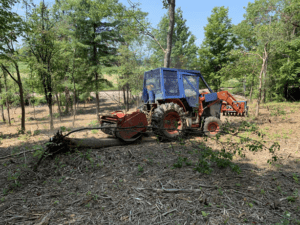Battling Buckthorn

By Candace Page
A tearing, grinding hullabaloo arose as Gerry Hawkes drove his tractor into a seemingly impenetrable patch of common buckthorn below the Maple apartments one morning in August. The first phase of a long-term plan to reclaim nearly 13 acres of Wake Robin forest from the grip of invasive underbrush was nearing completion. The big, wedge-like teeth on the 2,500-pound shredder attached to the tractor’s back end ripped at the buckthorn. Rotating knives swallowed the small trees and spit them out in shreds. The machine drove deeper into the jungle, leaving behind a carpet of woody mulch.
“When I started here in 1992, this was all native forest with open areas of grass,” grounds manager Peter Hausermann explained as he surveyed the area from the third floor of Maple. That didn’t last: Buckthorn was on the march.
Common buckthorn is a vigorous, tree-like shrub, a European native imported to the United States as an ornamental in the 19th century. Like many invasives, it escaped from gardens into the wild and . . . went wild. Buckthorn leafs out early, creating shade and monopolizing nutrients so that native shrubs and saplings can’t compete. Its blue-black berries contain a natural laxative that makes them a poor food source for birds, who nevertheless spread the seeds.
“By 2005, the density of buckthorn down here was at the point you couldn’t walk through it,” Peter remembered. By 2021, it was difficult to see the few remaining large oaks, butternut, and ash in the woods; the jungle was a poor habitat for birds and wildlife.

But what to do? Removing buckthorn (and its sidekick, invasive honeysuckle) in any quantity is nearly impossible to accomplish by hand. “I’ve never seen anything like its root system,” Peter said. “It’s incredibly strong and tolerates any condition.” Though he had wanted to attack the problem for years, he had found no feasible method.
Then Wake Robin’s consulting forester, Joe Nelson, learned of Gerry Hawkes and his firm, Forest Savers. A Woodstock contractor and tinkerer, Gerry had turned his tractor into an assault force for clearing invasives in places where native trees need to be spared. “All of a sudden we saw the opportunity in the cheapest way possible to achieve something you can’t do manually,” Peter said.
Over many days this summer, Gerry and his tractor worked their way through 12.5 acres of woods in Wake Robin’s southwest corner. His machinery—debris rake on the tractor’s front, cutter/shredder on the back—cut down the invasives and chewed up everything, while leaving desirable trees untouched. (Much of the green and white ash went too, since those trees are doomed by the arrival of the emerald ash borer.)
Now, Joe Nelson said, there’s a chance for a different kind of woodland to thrive. Audubon Vermont’s Mark LaBarr, who also consulted on the project, said he hopes a variety of native shrubs will join the small clumps of native, fruit- bearing hawthorn left behind by the clearing work. Gray-stem and red-osier dogwood and viburnum, for example, “are great for pollinators, and they produce a great supply of berries in late summer and fall,” Mark said. Shrubland dwellers like gray catbirds and eastern towhees may be drawn to the area. “And we’d love to see blue-winged warblers and golden-winged warblers.” Joe and Mark will work with Wake Robin this winter to devise a master plan to guide future management of the woods.
If Wake Robin can succeed in preventing the resurgence of buckthorn and honeysuckle, the woodland between Maple and the railroad tracks will become a mosaic of native trees, grassy areas, and shrubs. That will require ongoing work for at least the next three to five years. The land will need to be mowed and brush-hogged to cut down the invasives that sprout from seeds and roots left behind by this summer’s work.

County forester Ethan Tapper visited the site and was impressed by what he saw, though he warned, “It’s the follow-up that will determine whether this is a success…there is so much buckthorn in the Champlain Valley that the threat will always be there.” He added that Wake Robin residents shouldn’t expect the cleared area to become a neat and pretty landscape. Not all the remaining trees will survive the change in their environment, and the brushy habitat attractive to birds can look messy to human eyes.

